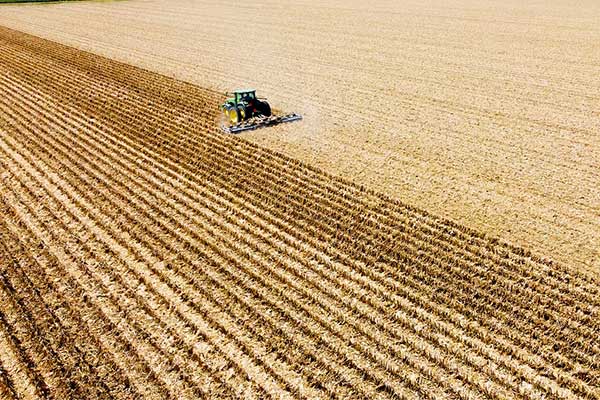From Swampland to Fertile Missouri Farm Ground
30-ft Cyclone Cutter creates efficiencies for Justin Littleton in Parma, MO
Parma, Missouri is located in the Little River Drainage District in Southeast Missouri. Once covered in water and trees, the state of Missouri acquired the land through The Swamp Land Act of 1850 for agricultural use. A grid of levees and ditches were created, eventually draining the 500,000 acres of swamp that created the most fertile agricultural land in the region.
When some row crop ground became available in this area in 2014, Justin Littleton took it and became a first-generation farmer. He had grown up farming with his grandfather, Bill Deane, two uncles and a few cousins, so farming isn’t entirely new. He also had friends and family to lean on for advice.
“Allen Below helped me so much when I started out on my own,” said Littleton. “There’s no way I could ever repay him or thank him enough for sharing his farming knowledge with me.”
When Littleton’s brother, Austin, joined in, the three farmers became inseparable. While on paper, their farms are two separate legal entities, they farm like they are one big operation.
“In today’s farming economic environment, you take advantage of, or create efficiencies, where you can. That’s our mindset as we work through every production year,” said Littleton.
“If it’s closer for me to use a piece of his equipment than it would be to haul or pull a piece of mine that’s several miles away, it’s an option and always an easy decision,” said Littleton. “It’s all about avoiding putting unnecessary time on a tach, conserving fuel and maximizing labor.”
On The Production Side
The three Missouri farmers split cotton, corn, soybeans, rice and peanuts across 12,000 acres of soils that vary as much as Missouri’s changing weather patterns.
“We farm some really light, sandy soil that we irrigate with pivots,” said Littleton. “We also have some Sharkey clay soil that’s a great fit for our soybeans and rice.”
Sandy and silt loam soils make up most of the fields, but a few farms change from sandy loam to Sharkey clay halfway across the field – which can make nutrient applications challenging.
To optimize and increase the efficiency of inputs, soil tests are conducted every year on their cotton, peanut and corn ground, and every other year on soybean ground. They also variable rate phosphate and potash when the soil tests dictate.
Going Big and Strong with Equipment
High speed planters, with 57-foot toolbars covering 18 rows, allow the three Missouri farmers to drop seeds into the ground at 10 mph. Transporting the planters is made easier because the wings stack fold. It also makes traveling from field to field much safer.
“You would think a planter that covers 18-rows would be a headache, but it’s done nothing but improve our planting efficiency,” said Littleton. Most farmers are running 12-row planters on 38-inch rows, but we went bigger and it’s worked well for us.”
The three farmers move as little dirt as possible. A mix of cover crops that includes cereal rye, vetch and radishes covers 90% of their row crop acreage. Each year, they experiment with a new cover crop species on 1,000 acres just to see how it performs.
“We have very few planting problems,” said Littleton. “We run row cleaners on our planters and are able to get excellent seed depth placement.”
After corn and cotton harvest, when stalks have to be cut, Littleton has experimented with a few options over the years. He has tried letting the stalks stand all winter, hoping they would decompose before running a do-all over them. That met with little success.
“The do-all just didn’t chop them up enough,” said Littleton. “If we can cut the tops of the stalks so the rain can get in, it leads to better decomposition and easier planting in the spring.”
They have also used bush hogs, but it left lines of unevenly distributed, moister-laden stalks wind rowed across the field that made planting more difficult.
They tried flail shredders, but they took a lot of power to operate. After about two or three years, balancing problems began.
“The flail shredders started vibrating violently and just beat themselves to pieces,” said Littleton. “That vibration led to welds breaking and bearings wearing out.”
Cyclone Cutter Offers Advantages and Efficiencies
In 2022, Littleton saw a neighboring farmer pulling a machine he wanted to know more about called the Cyclone, manufactured by Major Equipment. It was the first year his neighbor had used it so he couldn’t offer an opinion based on long-term use, but Littleton liked what he saw and wanted to try it.
“Greenway Equipment had a MJ30-920 Cyclone mower, and we decided to try it,” said Littleton. “It has a durable galvanized finish, spreads the stalks more evenly and I think offers a true advantage over a bush hog.”
There are fewer moving parts and that equates to less maintenance long-term.
“I don’t see it ever having balancing issues,” said Littleton. “We may have to change the blades, but I see us using it for a long time.”
Littleton had a bearing issue at one point, but Major Equipment had a fix for the issue quickly.
“They warranted the bearing and all parts – no questions asked,” said Littleton. “That impressed me almost as much as the Cyclone’s ability to fold up narrower than the insides of the duals on my tractors.”
There are a number of small bridges in the Little River Drainage District, but ferrying the Cyclone is not an issue for the three farmers.
“I’m going to run it another year over all my corn and cotton stalks to see how it holds up, but I don’t regret buying it at all,” concludes Littleton.
For a man that has built his farming operation on being efficient, that speaks volumes.




